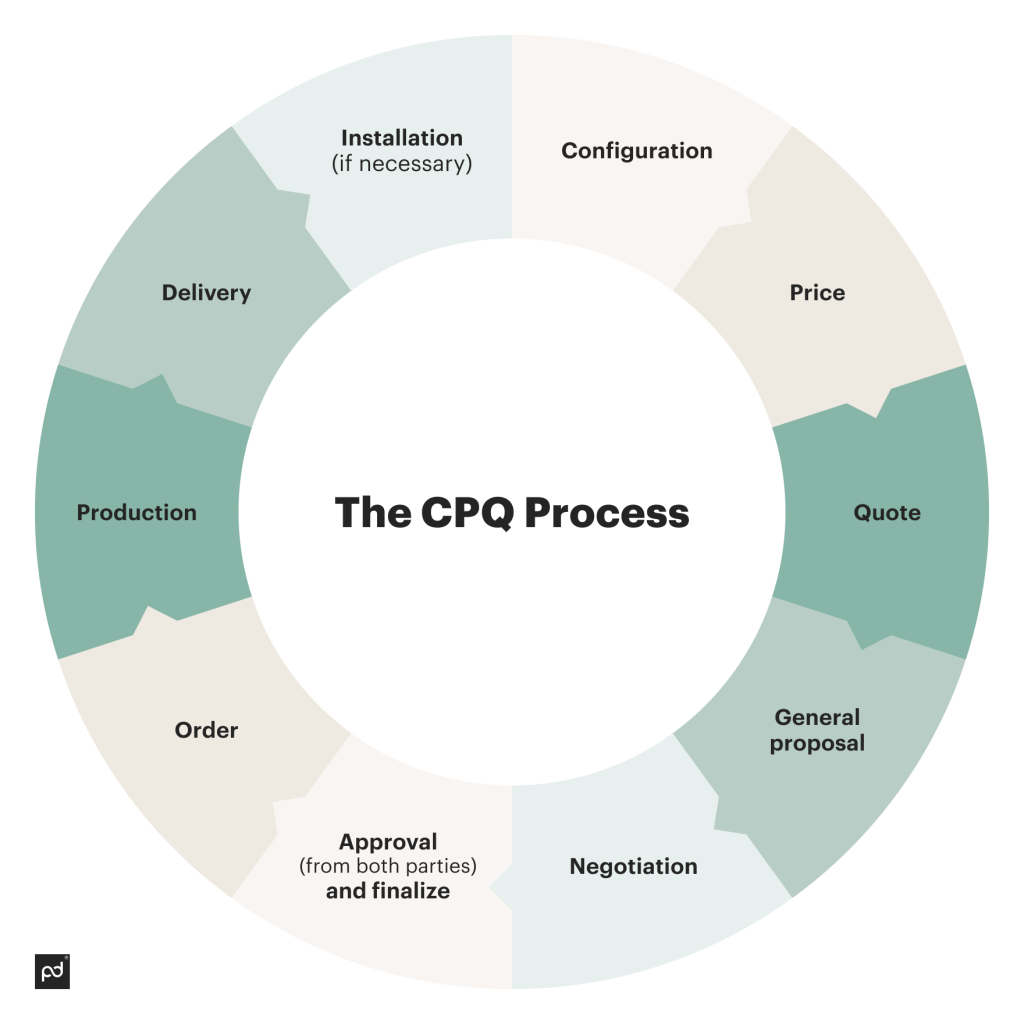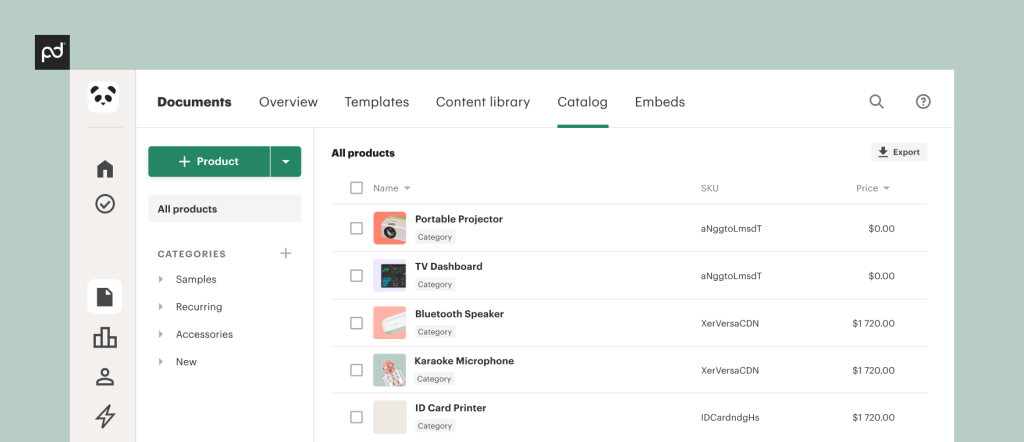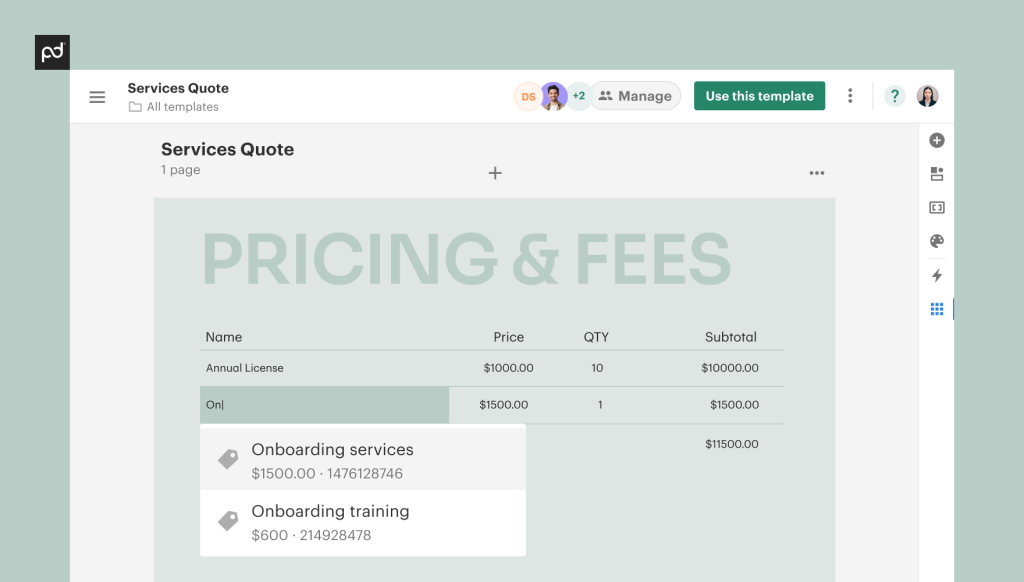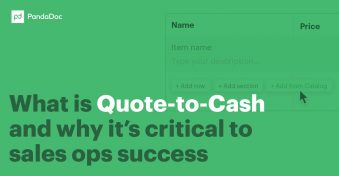Most modern sales processes can be broken into two main parts: Selling and paperwork.
In addition to selling the correct product or solution, sales reps need to generate accurate quotes in a timely fashion to close deals and ensure a positive customer experience.
Unfortunately, this process becomes more difficult as configurable products become more complex.
Upsells, additional product features, or a variety of models and functionality can all contribute to an elongated sales cycle.
Configure, Price, Quote (CPQ) solutions are designed to streamline the quoting process while ensuring accurate pricing.
That way, salespeople can focus less on paperwork and more on selling.
Let’s take a closer look.
What is CPQ?
CPQ — “configure, price, and quote” — is a three-step system used by sales teams to expedite quote-to-cash processes.
Using CPQ, sales reps can:
- Configure complex product orders based on customer needs.
- Price those customizations/add-ons efficiently.
- Quote the final price to the customer.
Modern CPQ systems can also connect with customer relationship management (CRM) software and/or enterprise resource planning (ERP) systems to further improve automation across multiple sales channels.
However, at its core, CPQ solutions are focused on streamlining the sales process through a combination of automation, fast quote configuration, and a reduction in human error.
1. Configure

The “Configure” stage of the CPQ process is largely focused on product configuration.
Here, complex products or services — from bespoke suits and custom vehicles to specialized software configurations — can be tailored to the unique needs and preferences of individual customers.
By bringing this technology to bear, organizations can vastly expand their product catalog, as well as the level of customization available to customers, without sacrificing speed and efficiency within the sales pipeline.
Here are a few examples where a CPQ tool can transform complex configurations into easy-to-create, customer-centric solutions:
- Customizing a computer. Choosing the processor, RAM, storage, graphics card, and other components to build a PC that meets the customer’s specific needs and budget.
- Configuring a car. Selecting the engine, transmission, trim level, color, interior options, and packages to create a personalized vehicle.
- Tailoring a software subscription. Choosing the number of users, features, and add-ons to match the customer’s requirements and scale as their business grows.
- Configuring an industrial machine. Choosing the capacity, features, and options to meet the customer’s production requirements and environment.
- Designing a custom home: Choosing the floor plan, exterior and interior finishes, fixtures, and appliances to build a dream home.
For businesses with a wide variety of product offerings, a CPQ implementation can dramatically expedite the sales pipeline by optimizing initial inputs, introducing dynamic pricing options, and increasing customer satisfaction.
2. Price

The “Price” stage in CPQ is where the configured product or service is assigned its final price tag.
Here, the detailed choices made in the “Configure” stage are translated into a concrete value that reflect a product’s unique composition, market conditions, and the customer’s perceived value.
With CPQ, pricing doesn’t need to be a one-size-fits-all proposition. A robust CPQ system allows businesses to deliver on this expectation, offering dynamic and intelligent pricing capabilities that factor in a wide range of variables.
This is particularly powerful for sales organizations, who can implement different pricing strategies based on available customization solutions.
A sophisticated pricing engine allows sales representatives to do the following:
- Generate accurate quotes instantly. No more manual calculations or guesswork. Quotes are generated in real time, reflecting the latest pricing information and ensuring accuracy and efficiency.
- Offer flexible pricing options. Customers can be offered a range of pricing options, such as tiered pricing, volume discounts, or subscription plans, catering to their specific needs and preferences.
- Maintain price rules and consistency. The system ensures that pricing is consistent across all sales channels, preventing discrepancies and confusion, and maintaining brand integrity.
- Gain insights into pricing performance. Many CPQ solutions track pricing data, allowing businesses to analyze and refine their pricing strategies over time, further maximizing revenue and profitability.
To further expedite this stage of the sales process, organizations can use automation tools like rule-based pricing models or similar predefined pricing structures.
Doing so can remove the guesswork related to costs and may eliminate the need for approval workflows entirely during the quoting process.
3. Quote

The “Quote” stage in CPQ is the culmination of the entire CPQ process. Here, the configured and priced product or service is presented to the customer in a formal, professional proposal.
Many CPQ solutions include an onboard quote generation software, but it’s also possible to offload this part of the process to platforms that specialize in this service. In either scenario, the idea system pulls together all the relevant information — including configuration details, pricing calculations, and any applicable terms and conditions – and generates a polished, error-free quote in a matter of seconds.
Quotes can be further expedited by connecting your CPQ system to your CRM or ERP systems, which may help teams to add customer data to quotes or to forward approved quotes directly to manufacturers in the supply chain for rapid production.
CPQ quoting features enable sales reps to do the following:
- Close deals faster. No more waiting days or even weeks for quotes to be prepared. Customers receive their proposals promptly, keeping the momentum going.
- Improve accuracy and professionalism. Quotes are generated automatically, eliminating manual errors and ensuring a consistent, professional look and feel.
- Enhance the customer experience. Customers receive clear, comprehensive quotes that are easy to understand and compare.
- Track and manage quotes effectively. The system provides a centralized repository for all quotes, making it easy to track their status and follow up with customers.
- Gain insights into quote performance. The system tracks quote acceptance rates and other metrics, providing valuable data for sales analysis and forecasting.
Generating quotes isn’t just about presenting a compelling value proposition to customers.
Especially when optimized through the appropriate integrations and via items features like templates, the right CPQ platform adds a measure of scalability to the quoting process.
These sales tools can entirely eliminate time-consuming, manual processes related to document generation.
Reps can get sales quotes out the door more quickly, regardless of deal size, and move on to other customers while quotes are being considered.
CPQ examples
The key benefits of CPQ are most obvious when selling configurable products like computers, vehicles, or furniture.
In these situations, a CPQ solution can expedite processes, allow for cross-selling and upselling, and help reps build more personalized options.
However, CPQ can also extend beyond these obvious use cases. Below, you’ll find several unusual scenarios where CPQs can be used to improve business processes.
Complex agreements in law firms
CPQ can be used for services as well as products.
Legal services are complex by nature and always require very extensive, precise definitions that may get altered beyond recognition after a series of edits.
A CPQ tool can help combine and manage various terms and conditions in legal services proposals and agreements, ensuring accuracy and compliance across the board through advanced document automation.
Put another way, teams can use CPQ to compile a list of predefined and accurately described services instead of writing definitions from scratch time after time or copying them from an existing document where they may have been customized for a particular client/case.
Custom IT services
Sales teams at software development and SaaS companies can use CPQ to quickly put together comprehensive quotes and proposals for custom services and development projects.
Standard blocks, service descriptions, and rates that form the skeleton of every proposal can be added to a document in seconds and then polished for specific project/client requirements.
Healthcare equipment/software sales
Intrinsically complex and subject to various compliance regulations, selling healthcare equipment and specialized software can benefit greatly from CPQ.
Enabling sales personnel to confidently configure medical hardware/software packages and save time on validation and approvals can provide a solid boost to conversion rates and help streamline how your business generates sales quotes.
For example, Interlace Health, an established supplier of software for hospitals and healthcare institutions, was able to cut down the proposal creation time by as much as 85% thanks to the use of PandaDoc and its advanced features like catalogs and pricing tables.
No matter your line of business you are in, CPQ software will help you build an efficient quote generation pipeline that relies on pre-approved templates and prices, convenient methods of routing quotes to relevant team members for approval, and then forwarding them to customers — often using electronic signature software for closing deals on the spot.
Do you need CPQ?
Now that we’ve talked about the CPQ process, CPQ software solutions, and the reasons why you may want to implement these tools and make them part of your standard workflow, let’s get into the specifics of how to take the next steps.
Step 1. Assess
Any CPQ software that you may consider will need to coexist with other solutions you use to manage your business on a daily basis.
On top of that, your primary task with CPQ implementation is to tackle existing inefficiencies.
Therefore, if you are already using an ERP, CRM, or document management platform, compatibility and native integration with those systems becomes one of the key criteria for choosing a CPQ solution.
Some CPQ solutions may be more focused on being an all-in-one tool that captures all customer data, while tools like PandaDoc can offer native integrations for popular CRM and accounting platforms.
Step 2. Select
Once you have your business pains written down, contact the vendors that you’ve shortlisted so far and ask them to demonstrate how their software can resolve these issues.
Request a demo and let them walk you through their product in a sandbox environment.
When shortlisting CPQ candidates, whenever possible, make sure to check out their list of clients.
For example, if you are an SMB, it would be great to find out that most of their clients represent the same type and size of business.
Keep in mind that the opposite is also true — if you are a large manufacturing enterprise, you would not want to find out that your growth may be hampered by the limitations of an SMB-oriented solution.
Step 3. Customize
Even the best CPQ software does not work perfectly “out of the box,” so get ready to invest some time and effort into populating up your product catalog, configuring specific products, setting product- or category-specific discount rules, as well as other important parameters.
Some CPQ products even allow you to use scripting to implement more complex price calculation and product configuration scenarios.
Step 4. Train
Your sales team will not be efficient without proper familiarization with their new tools.
Make sure everybody in your company understands the value of CPQ technology and knows how to use it to boost their performance.
The onboarding stage is also a great time to collect initial feedback and implement the necessary changes before the launch of the system.
Finally, keep in mind that effective CPQ implementation doesn’t stop once the first quote goes out.
Set periodic checks for CPQ performance assessments and gauge your sales performance regularly to get even better results.
End to end CPQ with PandaDoc
Not all CPQ tools are created equally. Some place a greater emphasis on customer relationship management while others focus entirely on quote generation.
Why pick and choose when you can have it all?
PandaDoc provides end-to-end document creation for teams of all sizes and industries. Our powerful CPQ tools — combined with both from-scratch and template-based document creation — helps teams eliminate spreadsheets and automate pricing processes.
With PandaDoc, you’ll get native integrations with major CRMs, as well as key payment gateways like Stripe, Square, and PayPal.
Our platform also comes with secure eSigning capabilities and a state-of-the-art document management system for all of your quoting and proposal generation needs.
To learn more with the help of our experts, start a 14-day trial today.
Frequently asked questions
-
While CPQ is technically separate from CRM, these two solutions often go hand-in-hand. Customer data from a CRM can be funneled into a CPQ process to expedite quote generation, track orders, and more.
This is such a common use case that CPQ solutions are offered by many CRM platforms as a way to utilize customer data and extend platform functionality.
For example, Salesforce CPQ is an add-on to the Salesforce Cloud platform. Similarly, Conga CPQ and Callidus CPQ integrate with their respective cloud environments to offer similar outputs.
Merging a CRM platform that manages data and customer interactions with a CPQ tool that supports sales teams streamlines processes and helps you keep all information in one place.
-
When searching for CPQ software, ensure it aligns with your core business needs in terms of configuration, pricing, and quoting capabilities.
Seamless integration with your existing systems and the ability to scale as your business grows are crucial.
Prioritize a user-friendly interface and comprehensive vendor support for smooth adoption.
Evaluate the pricing model and potential return on investment through increased sales efficiency and revenue. Finally, choose a reputable vendor with a proven track record of successful CPQ implementations.
-
As with all automation tools, CPQ software can help you build a reliable system that you can use to create standardized pricing and keep everyone on the same page.
While it can help you improve your sales workflow and quoting process in those ways, it won’t be able to help if you lack an understanding of what products you want to sell and how they need to be configured.
-
For the most part, yes. Most configure, price, quote software is industry agnostic.
For most CPQ tools, it won’t matter what products or services you add to the database. The tools and functionality of the software tool will work the same for every business and in nearly every scenario.
-
Not every CPQ tool will help you collect payments.
Some CPQ tools, like PandaDoc, come equipped with a payment gateway so that you can quote and bill at the same time.
On the other hand, Salesforce CPQ relies on Salesforce Billing — a completely separate module within the Salesforce platform — to handle payments and invoicing. Other CPQ systems may have no payment gateway functionality.
-
In a nutshell, customer relationship management (CRM) software handles customer profiles and keeps track of any customer orders and correspondence.
CPQ systems help you build and quote orders for customers that exist within your CRM database.
If you don’t already use a CRM platform, some CPQ tools may provide support or integrations with CRM solutions. PandaDoc, for instance, integrates with Salesforce and other platforms.
The Salesforce CPQ integration is one of the most popular because this powerful combination completely eliminates copying and pasting customer data into important sales documents. This means that your teams can consistently and rapidly produce quality collateral.
Users love the real-time document status updates delivered via the Salesforce dashboard that easily determine when prospects are interacting with received documents.
Because PandaDoc integrates with all Salesforce Sales Cloud editions, your business can effortlessly switch from Salesforce Classic to Lightning without losing any data in the process.
Disclaimer
PandaDoc is not a law firm, or a substitute for an attorney or law firm. This page is not intended to and does not provide legal advice. Should you have legal questions on the validity of e-signatures or digital signatures and the enforceability thereof, please consult with an attorney or law firm. Use of PandaDocs services are governed by our Terms of Use and Privacy Policy.
Originally published February 21, 2018, updated October 1, 2024


